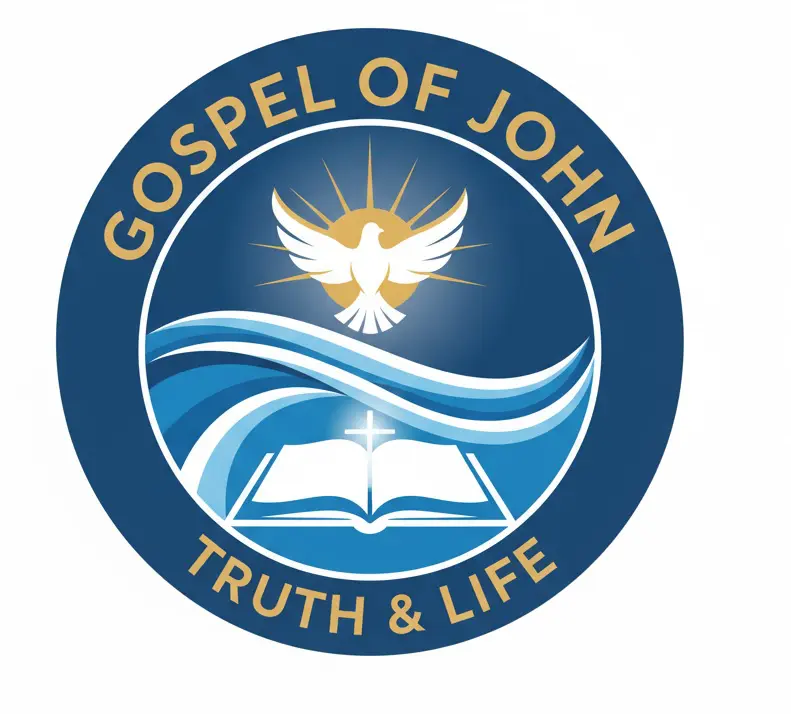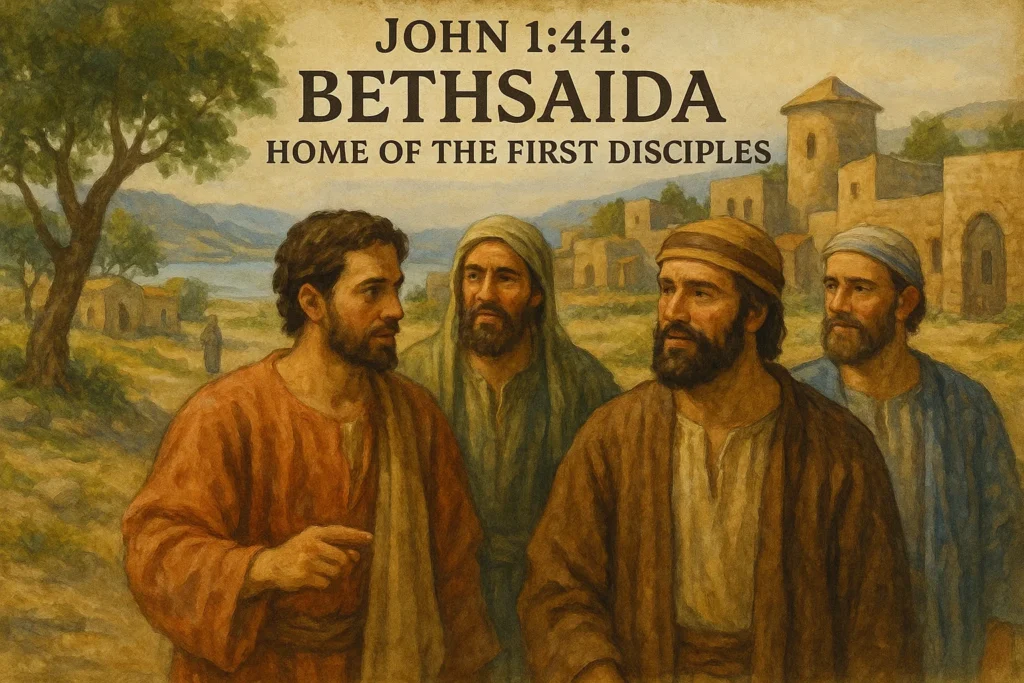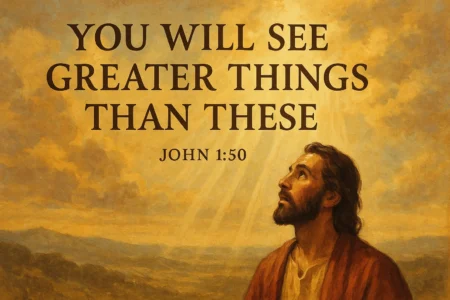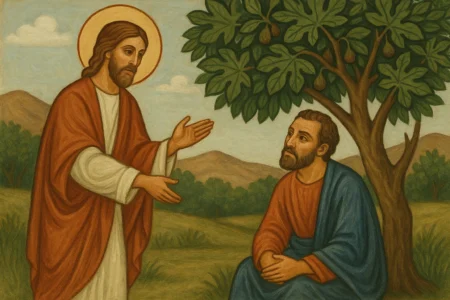It’s just one sentence. A single line of text tucked away in the first chapter of John’s Gospel, looking for all the world like a simple geographical note. “The next day Jesus decided to go to Galilee. He found Philip and said to him, ‘Follow me.’ Now Philip was from Bethsaida, the city of Andrew and Peter.” (John 1:44, ESV).
Most of us read right over it. I know I did for years. It’s the biblical equivalent of “SFO, the airport for San Francisco and Oakland.” A simple descriptor. A bit of trivia.
Right?
Wrong. This isn’t just a bit of geography. This verse is an origin story. It’s a pin dropping on a map, marking “ground zero” for the entire apostolic movement. This single verse connects the first men to answer Jesus’s call—Andrew, Peter, and Philip—to one specific, gritty, blue-collar town.
To truly understand the beginnings of Christianity, you have to understand this place. You have to smell the fish and feel the grit. This article provides a deep John 1:44 explained analysis, digging far beyond the surface to uncover why this one town, Bethsaida, became the unlikely hometown for a revolution. We’re going to unpack why this single verse is one of the most loaded, foundational, and ultimately tragic verses in the New Testament.
More in John Chapter 1 Category
Key Takeaways
- John 1:44 Explained: This verse identifies Bethsaida as the common hometown of the first disciples, Philip, Andrew, and Peter. This establishes a pre-existing social network that Jesus deliberately tapped into.
- Bethsaida’s Significance: This is no random detail. Naming Bethsaida (“House of the Fisherman”) grounds the Gospel in a real, historical, “blue-collar” location. It tells us Jesus began his work not with the elite, but with hardworking laborers.
- The “Hometown” Hub: The verse shows Jesus didn’t just call isolated individuals wandering in the desert. He called a community. These men already knew each other, trusted each other, and worked together, which almost certainly accelerated the formation of the first disciple group.
- The Capernaum “Problem”: Other gospels link Peter and Andrew to Capernaum. This isn’t a contradiction, as we’ll see. Bethsaida was their hometown (where they were from), while Capernaum was their adult residence (where they lived and based their fishing business).
- A Tragic Irony: Bethsaida, the town that produced the very first apostles and witnessed many of Jesus’s most profound miracles (like the feeding of the 5,000), was later personally and tragically rebuked by Jesus (Matthew 11:21) for its collective unbelief.
What’s Really Happening in This Single Verse?
Let’s slow down and actually read John 1:44. I mean really read it. Let the words breathe.
“The next day Jesus decided to go to Galilee. He found Philip and said to him, ‘Follow me.’ Now Philip was from Bethsaida, the city of Andrew and Peter.”
So much is packed in here. First, notice the divine initiative. “Jesus decided…” and “He found Philip…” Jesus is the one acting. He’s the one searching. Philip isn’t lost in a crowd; he is found. This single verb shatters any idea of the disciples just happening to be in the right place at the right time. This was a deliberate, sovereign, hand-picked choice. Jesus was on a mission.
Then comes the call.
It’s just two words: “Follow me.”
That’s it. No job description. No five-year plan. No list of benefits, no 401(k), no dental plan. It’s the simplest, yet most profound, invitation in history. It’s a call to leave everything—your career, your family, your past, your plans—and align your entire life with this one person. It’s a call to an unknown future, based only on the authority of the man who stands before you.
And Philip, to his eternal credit, does it. He goes.
But the verse doesn’t stop there. John, writing this Gospel decades after the fact, knows his audience will have a question. “Who is this Philip guy, and why does he matter?” John immediately answers by giving us Philip’s “street address” and, more importantly, his social circle. This is where it gets fascinating.
Why Does John Even Bother to Mention Bethsaida?
This is the real core of “John 1:44.” John adds, “Now Philip was from Bethsaida, the city of Andrew and Peter.”
This is not filler. This is not a throwaway line.
In the ancient world, your hometown defined you. It told people your trade, your accent, your likely social standing, and even your presumed character. Saying “he’s from Bethsaida” was like saying “he’s a steel-worker from Pittsburgh” or “he’s a tech guy from Silicon Valley” or “he’s a farmer from the rural Midwest.” It instantly created a picture.
And what was that picture? The name “Bethsaida” itself likely means “house of the fisherman” or “house of the hunter.” This was not a place of philosophers, priests, or kings. It was a hardworking, blue-collar fishing village on the north shore of the Sea of Galilee. This was a place of calloused hands, mended nets, and the constant, pervasive smell of fish and sea.
By linking all three men—Philip, Andrew, and Peter—to this one town, John is telling us something absolutely critical. These weren’t three random, isolated strangers whom Jesus collected like Pokémon.
They were neighbors.
They almost certainly grew up together. They played together. They mended nets on the same shore. They worked the same waters. They knew each other’s families.
Jesus wasn’t starting from scratch. He was deliberately tapping into a pre-existing, tight-knit community.
Think about the narrative flow. Just the day before, Andrew had been following John the Baptist. John points to Jesus and says, “Behold, the Lamb of God!” (John 1:36). Andrew immediately gets it. He spends the day with Jesus and then runs to find his brother, Peter, saying, “We have found the Messiah” (John 1:41). He brings Peter to Jesus.
What happens next? The very next day, Jesus decides to go to Galilee, and who does He find? Their hometown friend, Philip. You can almost picture the conversation. This wasn’t a cold call. Philip had probably already heard the buzz from his friends. This one geographical note reveals the very human, relational way the Gospel began to spread—not just as an abstract idea, but through established networks of trust. It started with friends telling friends.
Wait, I Thought Peter and Andrew Were from Capernaum?
This is where so many readers get tangled up. If you’ve read the other Gospels, you’re probably thinking, “Hold on a minute. Mark 1:21 and 1:29 clearly say Jesus entered Capernaum and went to the ‘house of Simon (Peter) and Andrew.'” Later, Capernaum is even called Jesus’s “own city” (Matthew 9:1), his base of operations.
So, which is it? Was John wrong? Were the other writers wrong? Is this a contradiction?
It’s not a contradiction at all. It’s just… life.
How many people do you know who still live in the exact same house they were born in? John 1:44 says Philip, Andrew, and Peter were from Bethsaida. This was their hometown, their place of origin, where their families were known, where they grew up.
Capernaum, just a few miles down the shore, is where Peter and Andrew lived as adults. It’s where they based their fishing business (a business they likely ran with their partners, James and John). It’s where Peter’s mother-in-law had a house, the one Jesus would later visit and where He’d heal her (Mark 1:30-31).
This is perfectly normal!
I was born in one state, but I’ve lived in my current city for over 15 years. If someone at a party asks where I’m “from,” I name my birthplace. It’s my origin story. But if you’re looking for my house or my office, you need my current address.
Bethsaida was their “from.” Capernaum was their “address.” It’s that simple. There’s no conflict, only a richer, more detailed picture of their lives.
Why Does This “Hometown” Detail Even Matter?
It matters because it grounds the story in gritty reality. It shows us the humble, earthy, “blue-collar” beginnings of this movement. Jesus didn’t start his recruitment in the libraries of Jerusalem or the halls of power in Rome. He started in a muddy fishing town with a group of friends who knew each other’s families.
This detail is a powerful reminder that faith isn’t an abstract philosophy. It’s something that happens in real places to real people.
I learned this the hard way. I went through a phase in my own life where I tried to find a “shortcut” in my faith. I thought I could skip the basics—the messy, everyday stuff—and jump straight to the “deep” theological insights. I read all the “advanced” books, listened to obscure lectures, and tried to sound smart.
It was a disaster.
It left me confused, arrogant, and completely ungrounded. My faith had no roots. It taught me the value of starting at the beginning, just as these disciples did. John 1:44 is that beginning. It’s the starting block. It reminds us that every great journey starts with a first step, in a real place, often with the people you already know. There are no shortcuts to a genuine “Follow me” moment. It has to be lived out on the ground, in your “Bethsaida” or your “Capernaum.”
So, Where Is This “Lost” City of Bethsaida?
Here’s where history, theology, and archaeology get really exciting. For centuries, nobody knew exactly where Bethsaida was. It was a “lost” city. It was mentioned in the Bible, by the Jewish historian Josephus, and by other ancient writers, and then it just… vanished.
But for the last few decades, archaeologists have been closing in. The search has centered on two main locations, and the debate is a fascinating window into how we connect our ancient texts to the modern soil.
The Case for Et-Tell: A City on a Hill?
For a long time, the leading candidate has been a site called Et-Tell. It’s a large, impressive mound (a “tell” is an archaeological term for a hill made up of layers of human settlement) located about a mile and a half from the current shore of the Sea of Galilee.
- The Arguments For: The excavations at Et-Tell (led for decades by the University of Nebraska at Omaha) are extensive. They’ve uncovered a major, fortified city that was inhabited from the Old Testament period right through the time of Jesus. They’ve found massive city gates from the time of King David, a palace (possibly), and numerous houses and fishing implements from the Roman period. The size and importance of the site seem to fit a place that Herod Philip (Herod the Great’s son) would later rebuild, elevate to the status of a “polis” (city), and rename “Julias” after the daughter of the Roman emperor.
- The Arguments Against: The big problem? It’s not on the water. For a “house of the fisherman,” being over a mile from the shore is a bit of a deal-breaker for many scholars. Supporters argue that the lake’s level has changed dramatically, or that a large lagoon once extended inland to the city, but the distance remains a significant challenge.
The Case for El-Araj: A Lakeside Contender?
More recently, a second site, El-Araj, has emerged as a very strong contender. This site is located directly on the shoreline, right where the Jordan River flows into the Sea of Galilee.
- The Arguments For: This location perfectly matches the description of a fishing village. You can practically cast a net from the ruins. Recent digs here have been incredibly fruitful. Archaeologists have found a Roman-era bathhouse, proving significant Roman settlement. They’ve found evidence of a first-century synagogue. Most stunningly, they’ve uncovered the remains of a large, ornate Byzantine-era church. Many scholars believe this church was built over the traditional home of Peter and Andrew, as described by an 8th-century pilgrim named Willibald. This has led many to believe this is the one.
- The Arguments Against: The site is still being excavated. While the evidence is compelling and growing every year, it’s not yet as extensive as the decades of work at Et-Tell.
Why Does Finding the Real Bethsaida Even Matter?
You might be thinking, “Who cares which pile of rocks is the right one? What does this have to do with faith?”
It matters. It matters profoundly.
I remember, a few years back, visiting a historical site from my own family’s past—a small, unassuming farmhouse in the old country. It was nothing special to look at. It was run-down, and the paint was peeling.
But standing on the same wooden floor where my great-grandparents stood, touching the same stone fireplace they used for warmth… it wasn’t just a history lesson. It was a connection. It was real. It made their story, which I had only heard, my story.
This is the same power Bethsaida holds.
When an archaeologist at El-Araj unearths a first-century fishing hook, a simple clay pot, or the stone foundation of a house, we are touching the world of Philip, Andrew, and Peter. It yanks the Bible out of the realm of “once upon a time” and slams it down onto the map. It proves these were not mythical figures in a fantasy land. They were real men who lived in a real town, who mended real nets, who got mud on their feet, and who got a real, life-changing invitation from a real person.
This isn’t about proving the Bible “true.” It’s about feeling its “truth.”
The Tragic Irony of Bethsaida
Here’s the part of the story that doesn’t usually make it into the feel-good sermons. If you only read John 1, you’d think Bethsaida was the gold-star town, the birthplace of the faith, the cradle of the apostles.
But it’s not the whole story.
This town, which was given the incredible privilege of producing the first disciples, became a special focus of Jesus’s ministry. The feeding of the 5,000 happened in a “desolate place” (Luke 9:12) just outside of Bethsaida. It was their people who were fed. Mark 8 records Jesus leading a blind man out of Bethsaida to heal him—a strange and intimate miracle, almost as if Jesus had to get the man away from the town’s toxic atmosphere of unbelief.
This town saw the evidence. It heard the call. It was front-row-center for the greatest events in history.
And it blew it.
As a whole, the town just didn’t get it. They saw the miracles as entertainment, not as a sign to repent and change. They saw Jesus as a wonder-worker, not a Lord. They ate the free fish and bread but refused the Bread of Life.
This leads to one of the most chilling, heartbreaking passages in the entire Bible.
What Went So Wrong? Jesus’s “Woe” to Bethsaida
In Matthew 11:21, Jesus, in a moment of profound grief and judgment, unleashes a heartbreaking “woe”:
“Woe to you, Chorazin! Woe to you, Bethsaida! For if the mighty works done in you had been done in Tyre and Sidon, they would have repented long ago in sackcloth and ashes. But I tell you, it will be more bearable on the day of judgment for Tyre and Sidon than for you.”
Stop and think about that.
Tyre and Sidon were infamous pagan cities, the “Las Vegas” and “Sodom” of the ancient world, synonymous with every kind of wickedness and idol worship. And Jesus says it will be better for them on judgment day than for Bethsaida.
Why?
Because with great privilege comes great responsibility. Bethsaida had seen the light. They had touched it. They had eaten its fruit. They knew their hometown boys were running with the Messiah. They saw the blind see and the thousands fed. They had seen the light, up close and personal, and chose to look away.
This is the tragic irony. The very town that John 1:44 lifts up as the “city of Andrew and Peter” is the same town that Matthew 11 condemns for its shocking, hard-hearted spiritual apathy. It’s a terrifying warning that being near Jesus is not the same as following Jesus.
What Does John 1:44 Mean for Us Today?
This single verse, when truly explained, is not just a history lesson. It’s a mirror.
The Power of a Simple Invitation: “Follow Me”
First, it reminds us that the call is the same. It’s not complicated. Jesus still finds people, often in the “Bethsaidas” of their lives—their ordinary, everyday, blue-collar worlds. At the office, in the shop, at school, in our homes. He doesn’t ask for a resume. He doesn’t ask for a theological degree. He just says, “Follow me.”
The question is, will we?
Will we, like Philip, immediately respond, drop our plans, and go?
Or will we, like the town of Bethsaida, watch the show, be amazed, and then go back to mending our nets, unchanged?
Are You from “Bethsaida”?
This, for me, is the final, powerful takeaway. Many of us are “from Bethsaida.”
What do I mean by that?
- We’ve grown up in the faith.
- We’ve been around the church our whole lives. We’ve heard the stories. We know the “language.” We know when to stand, when to sit, and what to say.
- We are close to the action. We’ve seen the “mighty works” in our own communities—lives changed, prayers answered, generosity on display.
We have the incredible, unearned privilege of knowing about Jesus. We live in a place of great spiritual light.
But the warning of Bethsaida hangs over us like a storm cloud. It is entirely possible to be the city of the disciples—to be the person who knows all the right answers, who sits in the front row, who even volunteers on a committee—and still miss the point entirely. It’s possible to be so familiar with Jesus that we are no longer awed by Him.
The story of John 1:44, when laid against the tragedy of Matthew 11, presents us with a choice. A stark one.
We can be like the town of Bethsaida: privileged, familiar, apathetic, and ultimately judged for the light we were given and ignored.
Or we can be like the men of Bethsaida: Philip, Andrew, and Peter. We can hear that simple, two-word call in our ordinary lives, drop whatever “nets” we’re holding—our pride, our plans, our excuses—and follow.
That’s the choice.
We started with one sentence. A simple geographical note. But in that one line, we found the entire story of the Gospel. We found the world-changing power of a personal call, the gritty reality of history, and the terrifying warning against taking it all for granted.
“John 1:44” is so much more than a Bible study. It’s a challenge. The call isn’t to a town. It’s not to an idea. It’s not to a religion. The call, then and now, is to a Person.
“Follow me.”
FAQ – John 1:44 Explained
What is the significance of Bethsaida in the story of the first disciples?
Bethsaida signifies the real, earthy roots of the early disciples, being a fishing village that represented the humble origins of those who followed Jesus, and it highlights the importance of community and everyday life in the spread of Christianity.
Why does the article emphasize the geographic details of Bethsaida and Capernaum?
These details reveal the difference between a town of origin (Bethsaida) and a place of residence (Capernaum), illustrating that Jesus called people from familiar, everyday environments, grounding the Gospel in real places and real lives.
What is the tragic irony associated with Bethsaida according to the article?
The irony is that Bethsaida, a town that produced the first disciples and witnessed many of Jesus’s miracles, was later rebuked by Jesus for its collective unbelief, showing that proximity to Jesus does not guarantee faithfulness.





